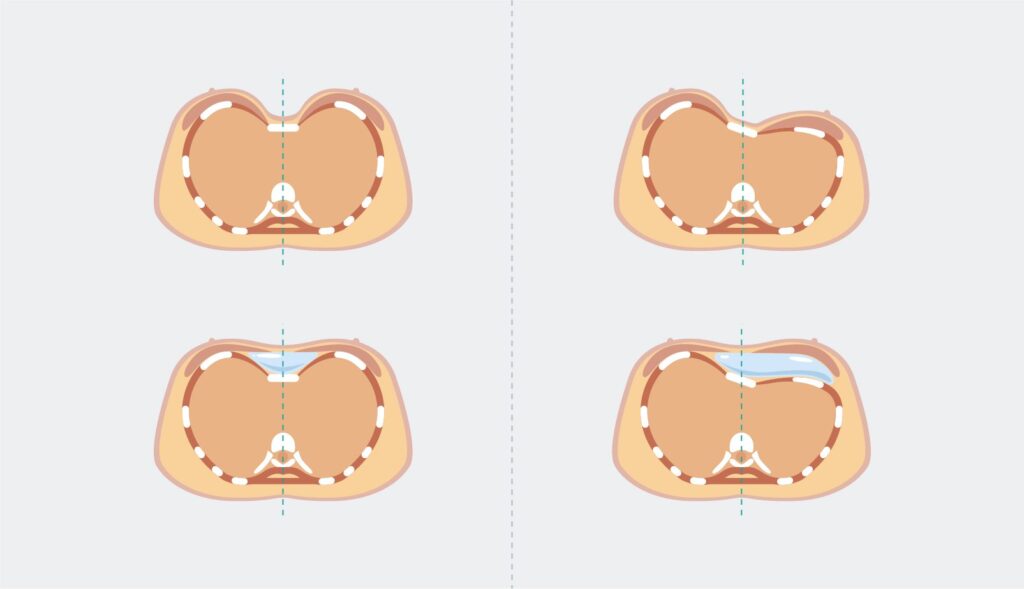Do you want to improve the appearance of your body?

The technology in reconstructive surgery allows us to correct developmental disorders such as the sunken chest, funnel chest or pectus excavatum. Pectus excavatum is a congenital problem that 1 out of every 700 born suffers and that mainly affects the male sex. Today the cutting edge of surgical treatment consists of the placement of an 3D implant designed as it adapts to the anatomy of each patient.
The pectus excavatum, sunken chest, or funnel chest is one of the most common disorders in the development and growth of costal cartilage. This problem consists of a sinking of the sternum that causes an alteration of the rib joints, which are deformed, projecting them, sometimes, forward.
Pectus excavatum is a condition whose cause is unknown; however, sometimes this disorder may be associated with other deformities such as osteogenesis imperfecta, rickets, scoliosis, Poland syndrome and others such as Marfan, Ehlers-Danlos, Noonan or Turner syndrome.
Although this congenital (from birth) disorder may not be noticeable during the first years of life or, even until the adolescence stage, the pectus excavatum makes the chest look somewhat sunken. According to Chiu PH, in A cross-sectional study of lung volume development in pectus excavatum patients this malformation can be classified according to its severity as:
On the other hand, in addition to the aesthetic effects on the patient, it must be taken into account that in severe cases, extra pressure is exerted on the lung and heart. This could lead not only to problems in exercising or physical activity, but more worryingly in respiratory complications, constant tiredness and fatigue, chest pain, palpitations and frequent bronchopulmonary infections. However, functional impairment by a pectus excavatum is extremely rare.
To date, thoracic surgery has been the only effective treatment to correct this defect. For the treatment of the pectus excavatum there are several types of surgical procedures such as the Nuss, Ravitch technique, or the Taulinoplasty. At Antiaging Group Barcelona we have a definitive and safe method to solve this congenital problem of the rib cage, by the Anatomik Modeling company.
This company has created a custom implant based on chest deformity using a CT scan. The implant covers and models the entire defect and is implanted in depth, following Professor Chavoin’s technique, partially covered by the pectoralis major musculature. The advantages of this surgical technique are:

Silicone implants are designed virtually after performing a CT scan of the patient and using a computer-assisted process, in which the thoracic cavity is rebuilt. These implants offer a minimally invasive, safe and simple solution to the pectus excavatum, avoiding open chest surgeries and their possible complications.

The surgical procedure is carried out under general anesthesia and lasts about 60 minutes, in which the surgeon makes an incision in the chest cavity from which the implant slides. Then hospitalization is one night. Subsequently, physical exercise should be avoided for 8-12 weeks depending on the size of the implant.
The reference centers in Anatomik Modeling, such as Antiaging Group Barcelona, have received theoretical and practical training on the computer construction of 3D implants and the different intervention techniques (pectus excavatum, Poland Syndrome or other deformities due to lack of muscles).
EXCELENTETrustindex verifica que la fuente original de la reseña sea Google. Maravillosa experiencia con la Doctora Salvador!!!Trustindex verifica que la fuente original de la reseña sea Google. Estic encantada! Son els millors!Trustindex verifica que la fuente original de la reseña sea Google. Muy profesionales. El trato es atento y cercano. Los resultados óptimos. He quedado muy satisfecho, los recomiendo totalmente.Trustindex verifica que la fuente original de la reseña sea Google. Es la mejor clínica. Yo fue operado por el Dr. Benito. Durante mucho tiempo elegí una clínica y un médico, dudé. Pero tuve mucha suerte, ¡caí en manos de oro! Estoy muy contenta con el resultado inmejorable. El doctor es un especialista muy atento y elegante. Todo el personal de la clínica es muy agradable. ????????✨????Trustindex verifica que la fuente original de la reseña sea Google. Muy buena clínica, la doctora Salvador explica todo de manera que sabes que estas en buenas manos.Trustindex verifica que la fuente original de la reseña sea Google. Espectacular resultado gracias al dr.benito y a su equipo????Trustindex verifica que la fuente original de la reseña sea Google. Hace más de 15 años que confío en el doctor Jesús Benito. Un gran cirujano y una persona encantadora. Gracias por todos los cuidados !!!!Trustindex verifica que la fuente original de la reseña sea Google. Muy agradecido al Dr Benito por la confianza que se gana y que te ayuda a tomar decisiones. Muy satisfecho con su profesionalidad y los resultados. Y muy contento con su equipo por lo cómodo y fácil que te hacen todo.
He worked at the Hospital Clínic in Barcelona as a specialist in Plastic and Reconstructive Surgery for 16 years.
Fifteen years ago, together with two other professionals, he founded Antiaging Group Barcelona, at the forefront of Aesthetic Medicine and Surgery. He has developed professionally in the field of care, research and teaching, being his fields of interest facial surgery, breast surgery and body contouring with implants.
In breast surgery he is a specialist in transaxillary breast augmentation and secondary breast surgery. He has introduced the use of ultrasound in Plastic Surgery and recently the use of 3D implants in thoracic malformations.
No physical exercise for 6 to 8 weeks. Return to work in 1-4 weeks, depending on the work performed.
This surgery leaves scars, but our goal is to minimize them as much as possible and make them as inconspicuous as possible. Usually, the incision is made in the lower part of the sternum and the resulting scar can be easily concealed with clothing. In addition, we use advanced suturing and skin adhesion techniques to minimize the appearance of scars. It is important to follow postoperative instructions carefully, and it may also be helpful to use topical products to reduce the appearance of the scar after recovery.
Medical Quality







Follow us